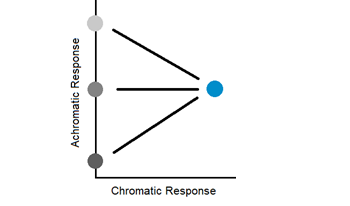
Luminance underestimates the brightness of chromatic visual stimuli. This phenomenon, known as the Helmholtz-Kohlrausch effect, is due to the different experimental methods—heterochromatic flicker photometry (luminance) and direct brightness matching (brightness)—from which these measures are derived. This paper probes the relationship between luminance and brightness through a psychophysical experiment that uses slowly oscillating visual stimuli and compares the results of such an experiment to the results of flicker photometry and direct brightness matching. The results show that the dimension of our internal color space corresponding with our achromatic response to stimuli is not a scale of brightness or lightness.
Luke Hellwig, Dale Stolitzka, Mark Fairchild, "Why Achromatic Response is not a Good Measure of Brightness" in Color and Imaging Conference, 2022, pp 1 - 5, https://doi.org/10.2352/CIC.2022.30.1.02
 Find this author on Google Scholar
Find this author on Google Scholar Find this author on PubMed
Find this author on PubMed